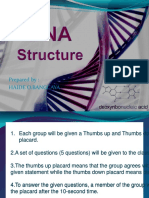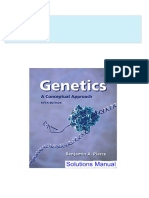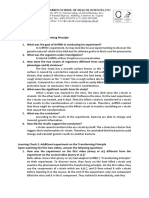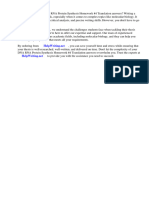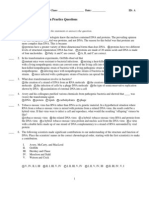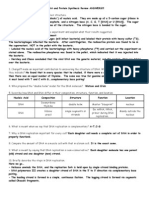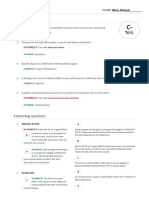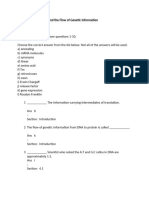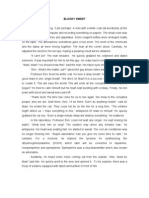Ch. 16 Part 1
Ch. 16 Part 1
Uploaded by
dollymiqCopyright:
Available Formats
Ch. 16 Part 1
Ch. 16 Part 1
Uploaded by
dollymiqCopyright
Available Formats
Share this document
Did you find this document useful?
Is this content inappropriate?
Copyright:
Available Formats
Ch. 16 Part 1
Ch. 16 Part 1
Uploaded by
dollymiqCopyright:
Available Formats
MasteringBiology: Assignment Print View
Ch 16 - Part I - Homework - Dr. No
Due: 11:59pm on Monday, November 7, 2011
Note: You will receive no credit for late submissions. To learn more, read your instructor's Grading Policy [Switch to Standard Assignment View]
Activity: DNA and RNA Structure
Click here to complete this activity. Then answer the questions. Part A In the accompanying image, a nucleotide is indicated by the letter _____.
ANSWER:
C A D
MasteringBiology: Assignment Print View
E B
Correct
B is indicating a single nucleotide.
Part B Which of these is a difference between a DNA and an RNA molecule? ANSWER:
DNA is a polymer composed of nucleotides, whereas RNA is a polymer composed of nucleic acids. DNA is double-stranded, whereas RNA is single-stranded. DNA contains uracil, whereas RNA contains thymine. DNA contains nitrogenous bases, whereas RNA contains phosphate groups. DNA contains five-carbon sugars, whereas RNA contains six-carbon sugars.
Correct
(With some exceptions) DNA is a double-stranded molecule and RNA is a single-stranded molecule.
Part C This is an image of a(n) _____.
MasteringBiology: Assignment Print View
ANSWER:
none of the above thiol nucleic acid nucleotide amino acid
Correct
Nucleotides are composed of a pentose sugar, a nitrogenous base, and a phosphate group.
Part D The letter A indicates a _____.
ANSWER:
sugar nucleotide none of the above nitrogenous base phosphate group
Correct
Phosphate groups contain phosphorus..
Part E A nitrogenous base is indicated by the letter _____.
MasteringBiology: Assignment Print View
ANSWER:
C A B E D
Correct
This is a nitrogenous base.
Part F You can tell that this is an image of a DNA nucleotide and not an RNA nucleotide because you see a _____.
MasteringBiology: Assignment Print View
ANSWER:
double-stranded molecule, not a single-stranded molecule sugar with two, and not three, oxygen atoms uracil nitrogenous base, not a thymine nitrogenous base phosphate group, not a uracil thymine nitrogenous base, not a uracil nitrogenous base
Correct
DNA nucleotides are composed of deoxyribose sugars, whereas RNA nucleotides are composed of ribose sugars.
Part G Which of these nitrogenous bases is found in DNA but not in RNA? ANSWER:
adenine thymine uracil guanine cytosine
Correct
DNA contains thymine; RNA does not.
Part H Which of these is(are) pyrimidines?
MasteringBiology: Assignment Print View
ANSWER:
B and C A and B B, C, and D A, B, and C C, D, and E
Correct
Pyrimidines are single-ring structures.
Part I In a nucleotide, the nitrogenous base is attached to the sugar's _____ carbon and the phosphate group is attached to the sugar's _____ carbon. ANSWER:
2' ... 1' 2' ... 3' 1' ... 5' 1' ... 2' 1' ... 3'
Correct
The nitrogenous base is attached to the sugar's 1' carbon and the phosphate group is attached to the sugar's 5' carbon.
MasteringBiology: Assignment Print View
Part J Nucleic acids are assembled in the _____ direction. ANSWER:
4' to 5' 2' to 3' 5' to 1' 5' to 3' 1' to 5'
Correct
New nucleotides are added to the 3' end of a growing polynucleotide.
Part K In a DNA double helix an adenine of one strand always pairs with a(n) _____ of the complementary strand, and a guanine of one strand always pairs with a(n) _____ of the complementary strand. ANSWER:
thymine ... cytosine cytosine ... uracil guanine ... adenine uracil ... cytosine cytosine ... thymine
Correct
This is referred to as specific base pairing.
Activity: DNA Double Helix
Click here to complete this activity.
MasteringBiology: Assignment Print View
Then answer the questions. Part A In a DNA double helix an adenine of one strand always pairs with a(n) _____ of the complementary strand, and a guanine of one strand always pairs with a(n) _____ of the complementary strand. ANSWER:
guanine ... adenine cytosine ... uracil uracil ... cytosine thymine ... cytosine cytosine ... thymine
Correct
This is referred to as specific base pairing.
Activity: The Hershey-Chase Experiment
Click here to complete this activity. Then answer the questions. Part A This is an image of a _____.
MasteringBiology: Assignment Print View
ANSWER:
red blood cell phage bacterium protist moneran
Correct
This is a T2 phage, a type of phage that infects E. coli.
Part B Who demonstrated that DNA is the genetic material of the T2 phage? ANSWER:
Meselson and Stahl Darwin and Wallace Franklin Hershey and Chase Watson and Crick
Correct
Hershey and Chase did a series of classic experiments demonstrating that DNA is the genetic material of the T2 phage.
MasteringBiology: Assignment Print View
Part C The radioactive isotope 32P labels the T2 phage's _____. ANSWER:
tail base plate protein coat head DNA
Correct
The T2 phage consists of a protein coat and DNA. It is the DNA that contains P.
Part D Hershey and Chase used _____ to radioactively label the T2 phage's proteins. ANSWER:
32P 14C 35S 222Ra 92U
Correct
Hershey and Chase used radioactive sulfur to label the phage's proteins.
Part E After allowing phages grown with bacteria in a medium that contained 32P and 35S, Hershey and Chase used a centrifuge to separate the phage ghosts from the infected cell. They then examined the infected cells and found that they contained _____, which demonstrated that _____ is the phage's genetic material. ANSWER:
labeled DNA ... labeled protein labeled DNA .... protein labeled protein ... DNA labeled DNA ... DNA labeled protein .... protein
Correct
MasteringBiology: Assignment Print View
Since the phage DNA entered the infected cell, it makes sense that DNA is the genetic material.
Chapter 16 Pre-Test Question 1
Part A Griffith's experiments with S. pneumoniae were significant because they showed that traits could be transferred from one organism to another. What else did he find that was significant? Hint A.1 Hint not displayed
ANSWER:
A virus made the bacteria pathogenic. Heat kills bacteria. Protein could not be the genetic material. The transferred traits were heritable. DNA was the genetic material.
Correct
The fact that offspring of transformed bacteria also showed the pathogenic trait meant that the transforming agent had to be involved with the genetic material.
Chapter 16 Pre-Test Question 2
Part A In the Hershey and Chase experiment that helped confirm that DNA, not protein, was the hereditary material, what was the key finding? Hint A.1 Hint not displayed
ANSWER:
Radioactively labeled sulfur was present inside the infected bacteria. Radioactively labeled sulfur was found outside of the infected bacteria. Radioactively labeled carbon was present inside the infected bacteria.
MasteringBiology: Assignment Print View
Radioactively labeled phosphorus was present inside the infected bacteria. Radioactively labeled phosphorus was found outside of the infected bacteria.
Correct
When the bacteria had been infected with T2 phage whose DNA was tagged with radioactive phosphorus, the pellet of mainly bacterial material contained most of the radioactivity, indicating that the labeled phage DNA had entered the cells.
Chapter 16 Pre-Test Question 3
Part A Who conducted the X-ray diffraction studies that were key to the discovery of the structure of DNA? Hint A.1 Hint not displayed
ANSWER:
Griffith Franklin Chargaff McClintock Meselson and Stahl
Correct
Rosalind Franklin conducted these X-ray diffraction studies of DNA.
Chapter 16 Question 1
Part A In his work with pneumonia-causing bacteria and mice, Griffith found that ANSWER:
the protein coat from pathogenic cells was able to transform nonpathogenic cells.
MasteringBiology: Assignment Print View
the polysaccharide coat of bacteria caused pneumonia. heat-killed pathogenic cells caused pneumonia. bacteriophages injected DNA into bacteria. some substance from pathogenic cells was transferred to nonpathogenic cells, making them pathogenic.
Correct
Chapter 16 Question 3
Part A In analyzing the number of different bases in a DNA sample, which result would be consistent with the base-pairing rules? ANSWER:
A=G A+T=G+T A=C A+G=C+T G=T
Correct
Chapter 16 Question 6
Part A E. coli cells grown on medium are transferred to medium and allowed to grow for two
more generations (two rounds of DNA replication). DNA extracted from these cells is centrifuged. What density distribution of DNA would you expect in this experiment? ANSWER:
one high-density and one intermediate-density band one low-density band one intermediate-density band one low-density and one intermediate-density band one high-density and one low-density band
Correct
MasteringBiology: Assignment Print View
Chapter 16 Misconception Question 4
Part A Meselson and Stahl cultured E. coli for several generations in a medium with a heavy isotope of nitrogen, 15N. They transferred the bacteria to a medium with a light isotope of nitrogen, 14 N. After two rounds of DNA replication, half the DNA molecules were light (both strands had 14N) and half were hybrids (15N-14N). What did the researchers conclude from these results? ANSWER:
DNA replication is semiconservative. Opposite DNA strands are complementary to each other. The nitrogenous bases in DNA molecules incorporate both 15N and 14N.
Correct
Correct! Read about Meselson and Stahls experiment in Inquiry Figure 16.11.
Score Summary:
Your score on this assignment is 99.5%. You received 23.88 out of a possible total of 24 points.
You might also like
- My Husband With Scholars Syndrome (Chapter 1 - Chapter 40)Document404 pagesMy Husband With Scholars Syndrome (Chapter 1 - Chapter 40)NarshaNo ratings yet
- Which of The Following Plants Was Used by Gregor Mendel To Formulate His Laws of InheritanceDocument3 pagesWhich of The Following Plants Was Used by Gregor Mendel To Formulate His Laws of InheritanceMohammad Ryyan Pumbagul50% (2)
- Science: Modified Strategic Intervention MaterialsDocument28 pagesScience: Modified Strategic Intervention MaterialsSanJoseHS100% (2)
- BIO3170 - Practice Midterm 1 PDFDocument5 pagesBIO3170 - Practice Midterm 1 PDFJohn DoeNo ratings yet
- A Detailed Lesson Plan in Science 10: Panpacific University Urdaneta City, Pangasinan School of Basic EducationDocument5 pagesA Detailed Lesson Plan in Science 10: Panpacific University Urdaneta City, Pangasinan School of Basic EducationGomez Agustin LeslieNo ratings yet
- The Molecular Basis of InheritanceDocument35 pagesThe Molecular Basis of Inheritanceprehealthhelp80% (5)
- Protein SynthesisDocument67 pagesProtein SynthesisLian Rose MendozaNo ratings yet
- Biotechnology LasDocument6 pagesBiotechnology LasAYESA MIELLE MANECLANGNo ratings yet
- Dna - CotDocument39 pagesDna - CotJcob BangcayaNo ratings yet
- DNA ReplicationDocument32 pagesDNA ReplicationSudipta MandolNo ratings yet
- AP Q Chapter 3Document68 pagesAP Q Chapter 3Mahra AlketbiNo ratings yet
- Science 10 q3 Week 4 Lessons 8-11Document33 pagesScience 10 q3 Week 4 Lessons 8-11JennyFloresNicolas100% (2)
- Molecular basis of inheritance (Edustudy point)_unlockedDocument15 pagesMolecular basis of inheritance (Edustudy point)_unlockedatulydv52No ratings yet
- Quizlet Chapter 16Document10 pagesQuizlet Chapter 16EUNAH LimNo ratings yet
- PDF Genetics A Conceptual Approach 5th Edition Pierce Solutions Manual DownloadDocument37 pagesPDF Genetics A Conceptual Approach 5th Edition Pierce Solutions Manual Downloadkarniacreel100% (2)
- Dna Molecule Model Exercise No. 3 NAME: Shanica E. Surigao Course and Year: Bsed I - ScienceDocument8 pagesDna Molecule Model Exercise No. 3 NAME: Shanica E. Surigao Course and Year: Bsed I - ScienceShamaica SurigaoNo ratings yet
- DNA StructureDocument39 pagesDNA StructureCitra Lusyana0% (1)
- Science-10 Q3 Week-4 Lessons-8-11 27Document16 pagesScience-10 Q3 Week-4 Lessons-8-11 27Azhell VillasotoNo ratings yet
- Dna Denaturation & Renaturation200328060603033131Document16 pagesDna Denaturation & Renaturation200328060603033131onwukapaul21No ratings yet
- TolentinoKatrice MLS3-1 LearningCheck1235Document5 pagesTolentinoKatrice MLS3-1 LearningCheck1235KJDTolentinoNo ratings yet
- IB BladDocument8 pagesIB BladVara Prasad Raju PNo ratings yet
- Orca Share Media1662355444548 6972424090491517852Document9 pagesOrca Share Media1662355444548 6972424090491517852Mic Houston Mar T. ParroNo ratings yet
- Dna Replication & TranscriptionDocument4 pagesDna Replication & TranscriptionGarren Jude AquinoNo ratings yet
- DNA Replication Review WorksheetDocument8 pagesDNA Replication Review WorksheetSamya SehgalNo ratings yet
- Immediate download Genetics A Conceptual Approach 5th Edition Pierce Solutions Manual all chaptersDocument44 pagesImmediate download Genetics A Conceptual Approach 5th Edition Pierce Solutions Manual all chaptersfrahatorac100% (4)
- Dna Rna Protein Synthesis Homework 4 Translation AnswersDocument5 pagesDna Rna Protein Synthesis Homework 4 Translation AnswersCustomPapersReviewSingapore100% (2)
- Molecular Biology: Principles and PracticeDocument34 pagesMolecular Biology: Principles and PracticesabweedNo ratings yet
- Grade 10 ch8 WorksheetDocument11 pagesGrade 10 ch8 Worksheetmanar.artanNo ratings yet
- MolecularDocument4 pagesMolecularalvinaNo ratings yet
- Science Quarter 3-Module 2 DNA: NameDocument7 pagesScience Quarter 3-Module 2 DNA: NameChristian jade QuijanoNo ratings yet
- DLP-DNA Genetic Material 071219Document4 pagesDLP-DNA Genetic Material 071219IRIS100% (1)
- Elite G11 Biology Exam Coverage Practice T3 22-23: Chemical Building Blocks Called NucleotidesDocument29 pagesElite G11 Biology Exam Coverage Practice T3 22-23: Chemical Building Blocks Called NucleotidesMahra AlketbiNo ratings yet
- Chapter 8 Worksheet Packet KEY - HB 2016Document6 pagesChapter 8 Worksheet Packet KEY - HB 2016O.N.UNo ratings yet
- Ncert Solutions Class 12 Biology Chapter 6 Molecular Basis of Inheritance - 0Document11 pagesNcert Solutions Class 12 Biology Chapter 6 Molecular Basis of Inheritance - 0riosjerit1234No ratings yet
- Chapter 16 TestDocument8 pagesChapter 16 TestthevertabreakerNo ratings yet
- 12 2 WKSTDocument4 pages12 2 WKSTapi-262378640No ratings yet
- 1 QCM Bio MolarDocument11 pages1 QCM Bio MolarPiseth VichhekaNo ratings yet
- Lesson 6.4 DNA Its Role in Inheritance and Protein SynthesisDocument40 pagesLesson 6.4 DNA Its Role in Inheritance and Protein Synthesisgwynangelsaturgo07No ratings yet
- Central Board Od Secondary EducationDocument17 pagesCentral Board Od Secondary EducationSk Samir UddinNo ratings yet
- DNA and RNA, Part 2Document15 pagesDNA and RNA, Part 2shiyiNo ratings yet
- DNA MetalcomplexDocument25 pagesDNA MetalcomplexclrichemNo ratings yet
- Dna Review AnswersDocument2 pagesDna Review AnswersShi Jie100% (1)
- Pierce SM Chapter10Document10 pagesPierce SM Chapter10vaishali shuklaNo ratings yet
- Answer 1:: (Class - XII)Document9 pagesAnswer 1:: (Class - XII)Subhadip MurmuNo ratings yet
- DisadvantagesDocument9 pagesDisadvantagesSubhadip MurmuNo ratings yet
- 2011 Semifinal AnswersDocument43 pages2011 Semifinal AnswersSamsamaNo ratings yet
- Quiz 1: Introduction To Molecular BiologyDocument4 pagesQuiz 1: Introduction To Molecular BiologyLuis MartinezNo ratings yet
- Biology (9-11-24) KEYDocument10 pagesBiology (9-11-24) KEYhumairsk2020No ratings yet
- Ch-6-Study Material-2024-2025Document21 pagesCh-6-Study Material-2024-2025zahraababy123No ratings yet
- Test - DNA Replication & History of DNA - AP Biology - Quizlet PDFDocument4 pagesTest - DNA Replication & History of DNA - AP Biology - Quizlet PDFNzizaRichardNo ratings yet
- Lesson-3 Protein-Synthesis WorksheetDocument10 pagesLesson-3 Protein-Synthesis WorksheetEnriquez, Hannah Roniella R.No ratings yet
- Genetic MaterialDocument2 pagesGenetic MaterialSammie GotchuNo ratings yet
- CH 04Document10 pagesCH 04John Jeric San JoseNo ratings yet
- DnapageDocument2 pagesDnapageapi-258322847No ratings yet
- 02 Study Guide 8 2 - 8 3 ANSWERS 2Document6 pages02 Study Guide 8 2 - 8 3 ANSWERS 2KenzieNo ratings yet
- 01 The Genetic Material LHDocument41 pages01 The Genetic Material LHRADEN ALBERTUSNo ratings yet
- 1934 FdocDocument6 pages1934 Fdoctyleryawh2072No ratings yet
- 1.2.1.A WhatisDNAFDocument7 pages1.2.1.A WhatisDNAFBrettNo ratings yet
- Chapter 12: Molecular GeneticsDocument49 pagesChapter 12: Molecular GeneticsOttah Simon UdochiNo ratings yet
- Genetic Research PaperDocument10 pagesGenetic Research PaperDev raj regmiNo ratings yet
- Inbound 3235111451063110529Document7 pagesInbound 3235111451063110529Monica P. RamosNo ratings yet
- Dna, Gene, ChromosomeDocument7 pagesDna, Gene, Chromosomeupma sharmaNo ratings yet
- 1ps0 May 2020 Paper 1 Ms Edexcel Gcse PsychologyDocument23 pages1ps0 May 2020 Paper 1 Ms Edexcel Gcse Psychologygosha32daNo ratings yet
- Differentiate Plant Cell From Animal Cell. Salvalion ReportDocument18 pagesDifferentiate Plant Cell From Animal Cell. Salvalion ReportSj Miasco-MejongNo ratings yet
- DNA FingerprintingDocument20 pagesDNA FingerprintingShalini SinghNo ratings yet
- Bloody SweetDocument13 pagesBloody Sweetmaresnia100% (1)
- Jurnal Arifin-4Document14 pagesJurnal Arifin-4Arifin TasrifNo ratings yet
- Faculty of Psychology Bachelor of Science (Psychology) Curriculum Structure Document Academic YearDocument97 pagesFaculty of Psychology Bachelor of Science (Psychology) Curriculum Structure Document Academic YearKashyapi thakuriaNo ratings yet
- Class 9 Bio NewDocument4 pagesClass 9 Bio NewAshim KarjeeNo ratings yet
- Genetics Vocab ReviewDocument1 pageGenetics Vocab ReviewCameron Grace-Keller (HHS)No ratings yet
- CHEM243 Cheat Sheet 1Document5 pagesCHEM243 Cheat Sheet 1RATU CHOLILAH L.A.PNo ratings yet
- Bioinformatics AssignmentDocument29 pagesBioinformatics AssignmentThankGod Kelechi CasperNo ratings yet
- 63732dcb8d73120018c93481 - ## - PARISHRAM - Copy of BiologyDocument2 pages63732dcb8d73120018c93481 - ## - PARISHRAM - Copy of BiologysaintushNo ratings yet
- LXL - Gr12LifeSciences - 01 - DNA - The Code of Life - 05feb2014Document5 pagesLXL - Gr12LifeSciences - 01 - DNA - The Code of Life - 05feb2014Linda BurgNo ratings yet
- 17 20selftestDocument10 pages17 20selftestkateu232No ratings yet
- PDE 8A Isoforms Fasta SequencesDocument5 pagesPDE 8A Isoforms Fasta SequencesBekkem Lavanya ReddyNo ratings yet
- Lecture 1 DIFFERENCE BETWEEN SCIENCE AND ENGINEERINGDocument38 pagesLecture 1 DIFFERENCE BETWEEN SCIENCE AND ENGINEERINGkejevo1942No ratings yet
- Darwin's Theory of Evolution ?Document13 pagesDarwin's Theory of Evolution ?Dark mayersNo ratings yet
- Non-Medelian Inheritance PDFDocument12 pagesNon-Medelian Inheritance PDFbilly sauraNo ratings yet
- Okada, T., & Simon, H. A. (1997) - Collaborative Discovery in A Scientific DomainDocument38 pagesOkada, T., & Simon, H. A. (1997) - Collaborative Discovery in A Scientific DomainMustafa Emin PalazNo ratings yet
- Module 1-Zoology - HistoryDocument51 pagesModule 1-Zoology - HistoryVincent Miguel BastieroNo ratings yet
- Curriculum Guide in Science Grade X S.Y. 2020-2021: St. Scholastica'S Academy Tabunok, Talisay City, CebuDocument15 pagesCurriculum Guide in Science Grade X S.Y. 2020-2021: St. Scholastica'S Academy Tabunok, Talisay City, CebuWarley JabelNo ratings yet
- Henderson 2021Document62 pagesHenderson 2021David ValtierrezNo ratings yet
- Pulsed Electromagnetic Fields in Bone Healing MoleDocument18 pagesPulsed Electromagnetic Fields in Bone Healing MoleErickson OngNo ratings yet
- TrackDocument1 pageTrackHa TranNo ratings yet
- Ultraterrestrial Models - Harold PuthoffDocument18 pagesUltraterrestrial Models - Harold PuthoffjoseNo ratings yet
- Ch. 1 Part 3 - Five Unifying Themes in BiologyDocument2 pagesCh. 1 Part 3 - Five Unifying Themes in BiologyRiju DattaNo ratings yet
- 12th Bio-Zoology EM WWW - Tntextbooks.inDocument264 pages12th Bio-Zoology EM WWW - Tntextbooks.inbhavyasreeraja1098No ratings yet








